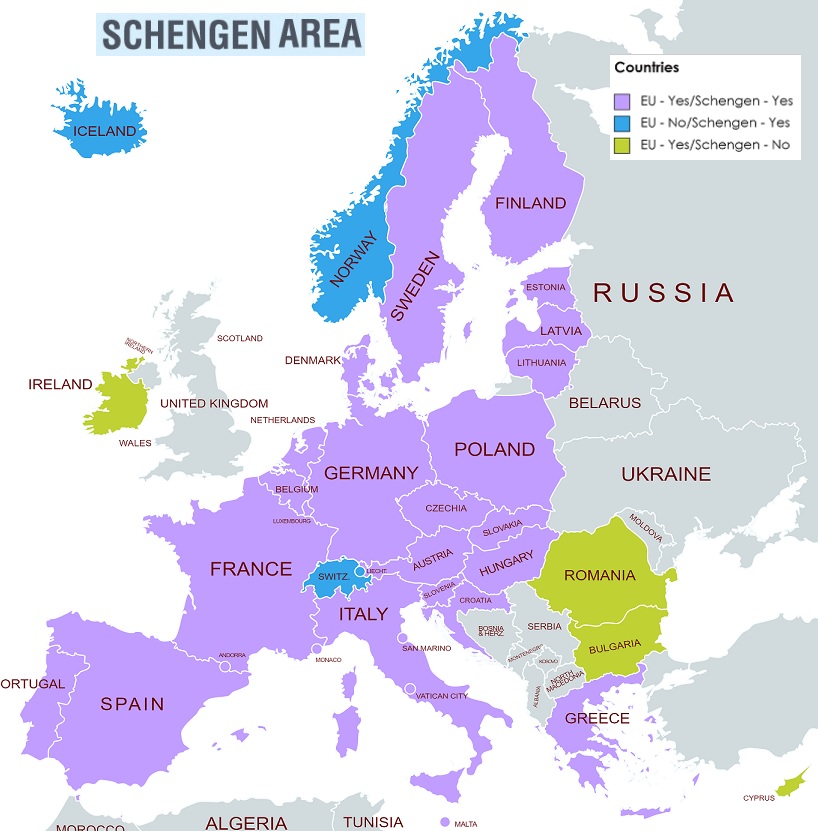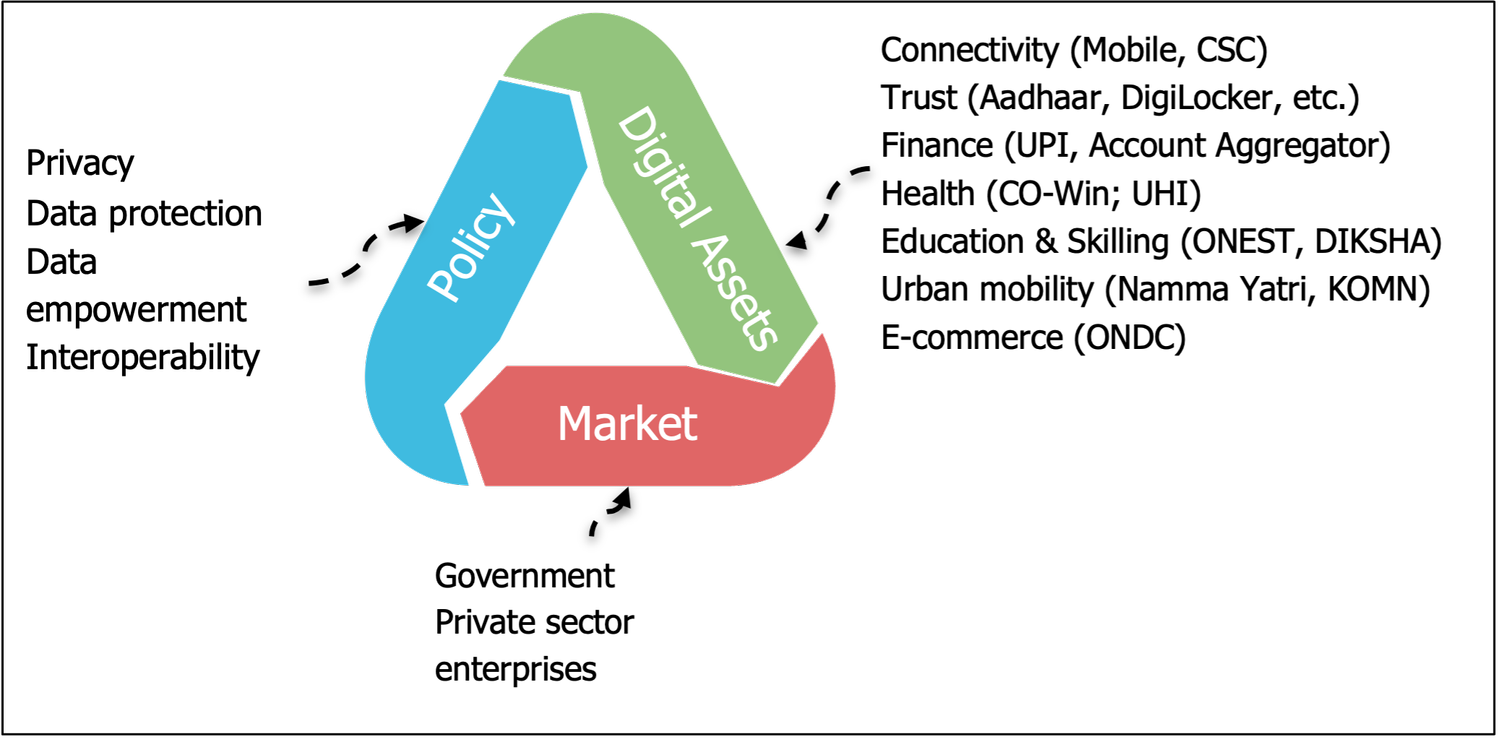Schengen Area
Recently, Kosovo secured visa-free access to the Schengen zone in Europe, world’s largest zone of free movement
- Schengen agreement – A treaty, signed in 1985 in Schengen, by France, Germany, Belgium, Luxembourg and Netherlands and came into force in 1995.
Schengen is a village in Luxembourg, bordering France and Germany.
- Aim – To abolish internal border checks and to provide a single set of rules for controls at the external borders in Schengen area.
- Parties – 27 countries
- Membership – It has allowed both EU and non-EU countries.
- Today, 23 of 27 EU countries are parties except Cyprus and Ireland but Bulgaria and Romania to join in March, 2024.
- It includes non-EU States like Iceland, Norway, Switzerland and Liechtenstein.

United Kingdom (UK) is a non-EU and non-Schengen Country.
- Schengen Visa – It is issued for short stays under 90 days.
- Benefits – Freedom to travel to other European nations without border checks.
- Alongside the single currency adopted by 20 EU countries, Schengen visa is the most visible symbol of European integration.
- Challenges – The flow of migrants and asylum seekers is seen as a threat to internal security and affected member states uses the Schengen Borders Code to introduce internal border controls.
Quick facts
- Kosovo - A Balkan nation which broke away from Serbia in 1999 and declared independence in 2008.
- It has not been accorded legal statehood by the UN and denied recognition by Russia and China.
- Balkan countries - Albania, Bosnia and Herzegovina, Kosovo, Montenegro, North Macedonia and Serbia.
Reference
The Hindu| Kosovo joining Schengen Area
National Commission for Scheduled Castes (NCSC)
Recently, Vice-Chairman (Chairman in-charge) of the NCSC submitted its annual report 2022-23 to the President of India.
- It is a constitutional body under Article 338 of the Constitution of India.
- Aim – To provide safeguards against the exploitation of SCs and Anglo Indian communities and to promote & protect their social, educational, economic and cultural interests.
- Composition (5) - Chairperson, Vice-Chairperson and 3 other Members.
- Appointed by – President, by warrant under his hand and seal.
- President may by rule determine the conditions of service and tenure of office of all the members.
89th Constitutional Amendment Act (2003), separated the erstwhile National Commission for Scheduled Castes and Scheduled Tribes into 2 separate commissions - National Commission for SC and National Commission for ST (NCST).
- Powers and Function – It shall have the power to regulate its own procedure.
- To investigate and monitor all matters relating to all safeguards provided for the SCs and to evaluate their working.
- To inquire into specific complaints with respect to the deprivation of rights and safeguards of the SCs.
- It has all the powers of a civil court like summoning attendance, requiring documents, receiving evidences, requisition public copy from court or office and examining the witnesses.
- To advise on the planning process of socio-economic development and to evaluate the progress under the Union and any State.
- To discharge such other functions as the President may, subject to the provisions of any law made by Parliament, by the rule specify.
- The Union and every State Government shall consult the Commission on all major policy matters affecting SCs.
- Report – Presented to the President, annually and at such other times as the Commission may deem fit where it recommends measures that should be taken by the Union or any State.
National Commission for Scheduled Tribes (NCST) under Article 338 (A) and National Commission for Backward Classes (NCBC) under Article 338 (B) are constitutional bodies for the protection and development of STs and BCs of India respectively.
References
- PIB| Annual Report of NCSC
- Constitution of India| Article 338 of Indian Constitution
Army Martial Arts Routine (AMAR)
Recently, a Punjab Regiment unit deployed close to the Line of Actual Control (LAC) in Kibithu in eastern Arunachal Pradesh, demonstrated their martial arts training to a group of visiting journalists.
- AMAR – A unique and standardised mixed martial arts (MMA) programme to train soldiers in basic and advanced techniques and manoeuvres of MMA.
- Induction of martial arts – Post the Galwan conflict in 2020, the Udhampur-based Northern Command introduced the Israeli-origin martial art Krav Maga.
- Later units picked up different martial arts based on their affiliations.
- The Ghatka – By the Punjab regiment
- The Khukri dance – By the Gorkha Regiment
- The Kalari Payattu – By the Madras regiment
- Aim – To improve soldier readiness and close-quarters fighting skills by focussing on offensive assault training and the ability to counter sharp-edged weapons.
Battle Preparedness and Efficiency Test (BEPT) is a mandate for all personnel up to 45 years of age once in every quarter. One has to run 5 km in 25 minutes for up to 30 years of age and for those above 30 years up to 40, additional 2 minutes are given.
|
Important Martial Arts
|
Origin State
|
|
Kalaripayattu
|
Kerala
|
|
Gatka
|
Punjab
|
|
Kuttu Varisai
|
Tamil Nadu
|
|
Silambam
|
Tamil Nadu
|
|
Thang-ta
|
Manipur
|
References
- The Hindu| Indian Martial arts Training for Army troops
- Times of India | Indian Martial Art Forms
India's open-sourced DPIs
India and Colombia signed a Memorandum of Understanding (MoU) on Cooperation to share India's open-sourced DPIs.
- India Stack Solutions – It is India's open-sourced DPI, a democratic and inclusive set of open Application Programming Interface (APIs) that stack upon each other to address various social challenges arising from economic underdevelopment.
- Digital public infrastructure (DPI) – It is a set of shared digital utilities powered by interoperable open standards providing equal access to drive innovation, inclusion, and competition at scale having open, transparent, and participatory governance.
Open source software (OSS) is software with a source code that that anyone can inspect, modify, and enhance with its original rights.
- Digital public goods (DPGs) – A set of digital assets made freely available allowing anyone to build and operate their own DPIs in a faster, cheaper, and interoperable manner.
- India’s DPI framework

- Significance – DPI approach can reduce implementation cost thereby increasing society-wide impact of digitalisation.
- It can make India genuinely a leader of the Global South, as is evident from the fact that 8 countries have already signed MoU for the stack.
India has launched Global DPI Repository (GDPIR), a virtual repository of DPI voluntarily shared by G20 members and beyond. Currently, the GDPIR features 54 DPIs from 16 countries.
References
- PIB| India Signs MoU with Columbia to Share India’s DPI
- Business Today| India’s DPI goes Global
Operations of Railway Protection Force
The Railway Protection Force (RPF) undertake various operations to safeguard railway property, passenger areas, and the well-being of travellers.
- Railway Protection Forces – It is established through RPF Act, 1957 and was amended in 1985 to make RPF an Armed Force.
- Aim – To ensure a safe and comfortable travel experience for all rail passengers and thereby upholding the values of integrity, compassion, and responsibility.
|
Operation
|
Objective
|
Significance
|
|
Nanhe
Faristey
|
Rescuing Lost Children
|
Reuniting the children in need of care and protection with their families.
|
|
Jeevan
Raksha
|
Saving Lives
|
Saving the lives of passengers who had accidentally fallen while de-boarding or boarding moving trains.
|
|
Meri
Saheli
|
Empowering Women Passengers
|
Providing security assurance to lady passengers.
|
|
Uplabdh
|
Cracking Down on Touts
|
Arresting touts and Seizing future reserved railway tickets.
|
|
NARCOS
|
Combating Drug Crimes
|
Arresting drug peddlers and seizing narcotics.
|
|
Yatri
Suraksha
|
Protecting Passengers
|
Supplementing police in preventing and detecting crimes against passengers.
|
|
Sanraksha
|
Ensuring Safety
|
Maintaining passenger safety from perilious acts of stone pelting on running trains.
|
|
Seva
|
Assisting Those in Need
|
Assisting elderly, sick or injured passengers during their rail travels.
|
|
Satark
|
Curbing Illegal Goods Transport
|
Seizing illegal tobacco products, illegal liquor and unaccounted cash, gold and silver.
|
In addition to this, RPF promptly addressed security-related passenger complaints through Rail Madad Portal and the Helpline (No. 139 integrated with Emergency Response Support System No. 112).
References
- PIB| Operation of RPF
- RPF| Railway Protection Force

